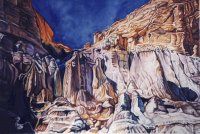
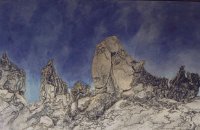
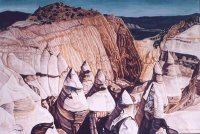
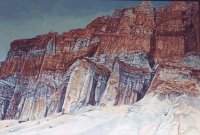

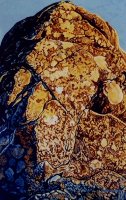
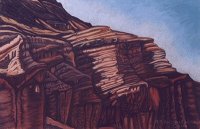
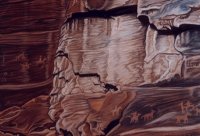



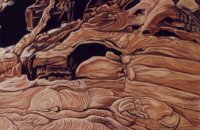
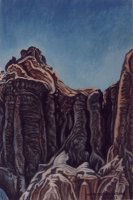

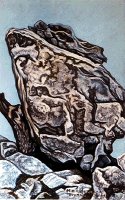
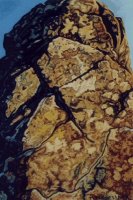
"Landscape as Architecture"
November 12 - December 14, 2005
at the Sylvia Winslow Gallery
of the Maturango Museum
Artist's Statement
"Landscape as Architecture" is the first of two conjoined series, the other series being "Architecture as Landscape." With both series I am dealing with fairly formal concerns.
With "Landscape as Architecture," those formal concerns are an examination of how best to render natural, stripped-to-its-geological-bones landscape in such a way that it implies the intent and interrelationships that we find in architecture. Such as:
- The conjunction of positive and negative space between adjacent towering rock formations that we might just as easily find between two skyscrapers.
- The rhythmic cadences of patterns of water-worn stone that are so nuanced and articulated that they could have been designed by human artifice as eye-pleasing surface decoration.
- The implication that by exercising our imaginations we can imbue landscape with the structural sense of purpose and human creativity implicit in architectural design.
With the second series, "Architecture as Landscape," I'll explore how to depict the artificial structures of architecture so that they begin to visually break down in our consciousness from their purpose of human function and instead take on the sensuous abstraction of nature's forms, and to reflect nature's cycle of birth, growth, decline, death, and rebirth. This particular series includes source materials from ancient sites which are, in fact, slowly reverting back to their natural components.
The idea is to set up a reverberation of sorts between the two series, until our visual perceptions of both the artificial and the natural begin to merge -- to focus our awareness, become more present to the physical aspects of the realities we find ourselves exposed to, immersed in.
I began this work initially with gouaches on big sheets of heavy-weight watercolor paper. Each takes months to execute. So after completing a few, I switched temporarily to chalk pastels on half-sheets of standard pastel paper as sort of two-dimensional maquettes, allowing me to explore a greater number of specific images before committing to the larger format.
In both the water media and the pastels, technically I tend to "massage" the pigment into the paper. I'm currently working again in gouaches, but this time the paper is stretched and mounted on wood. I enjoy the contrast between the opaque, soft glow of the pastels and the bright, stark crispness of the gouaches.
— M.M. Roessner-Herman